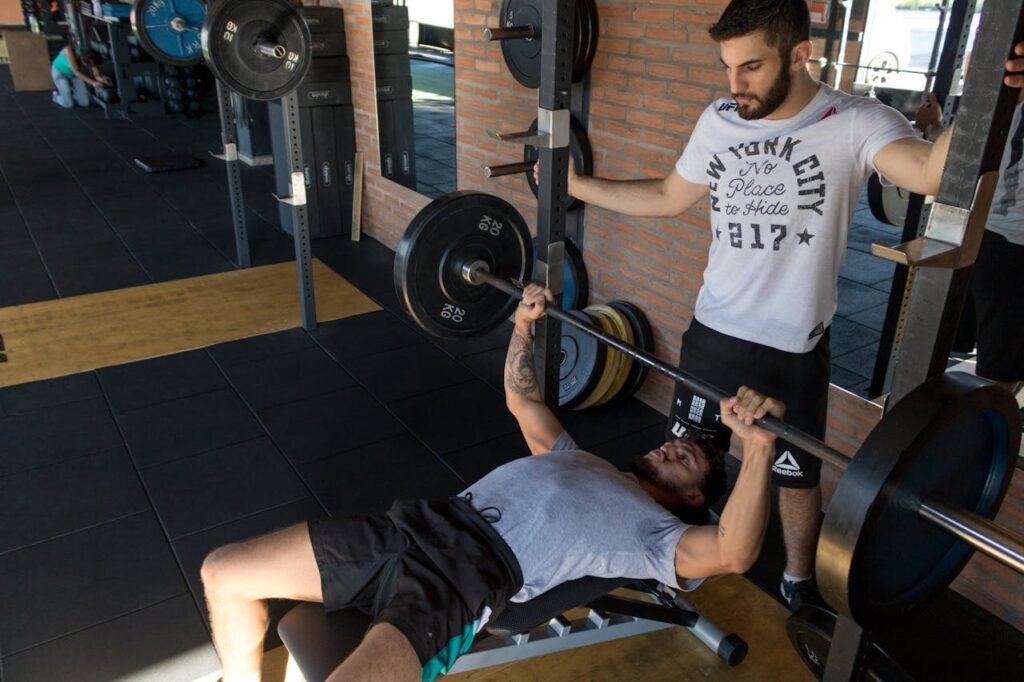The bear complex stands as one of the most challenging and effective full-body barbell workouts in the strength training world. This demanding sequence of five compound movements has earned its reputation among CrossFit athletes, powerlifters, and fitness enthusiasts as the ultimate test of strength, endurance, and mental fortitude.
Whether you’re looking to build muscle, torch fat, or develop functional strength that translates to real-world performance, the bear complex delivers results that few other exercises can match. But what exactly makes this workout so special, and how can you safely incorporate it into your training routine?
What is the Bear Complex?
The bear complex is a continuous sequence of five barbell exercises performed without setting the bar down or resting between movements. This unbroken chain creates an intense metabolic challenge that targets every major muscle group while testing your grip strength, cardiovascular endurance, and mental toughness.
The five movements that comprise one complete bear complex repetition are:
- Power Clean – Explosive pull from floor to shoulders
- Front Squat – Deep squat with bar in front rack position
- Push Press – Overhead press using leg drive
- Back Squat – Deep squat with bar on upper back
- Push Press (Behind the Neck) – Final overhead press to complete the cycle
What sets the bear complex apart from other barbell complexes is its seamless flow between movements and the fact that the barbell travels through multiple planes of motion, challenging your body’s stability and coordination in ways that isolated exercises simply cannot.
Complete Exercise Breakdown: Mastering Each Movement
Power Clean
The power clean initiates the bear complex and sets the tone for the entire sequence. This explosive movement develops power, coordination, and full-body strength.
Step-by-Step Technique:
- Start with feet hip-width apart, bar over mid-foot
- Grip the bar with hands slightly wider than shoulder-width
- Keep chest up, shoulders over the bar, and maintain a neutral spine
- Drive through your heels, extending hips and knees simultaneously
- As the bar passes your knees, explosively extend your hips and shrug your shoulders
- Pull yourself under the bar, catching it in a front rack position
- Stand to full extension to complete the movement
Pro Tips:
- Focus on keeping the bar close to your body throughout the pull
- Use your legs, not just your arms, to generate power
- Practice the catch position separately if you’re new to Olympic lifting movements
Front Squat
Immediately following the power clean, the front squat challenges your core stability and leg strength while maintaining the front rack position.
Step-by-Step Technique:
- From the front rack position, ensure elbows are high and chest is up
- Initiate the squat by pushing your hips back and bending at the knees
- Descend until your hip crease is below your knee cap
- Drive through your heels to return to standing position
- Maintain upright torso throughout the movement
Pro Tips:
- Keep your elbows high to prevent the bar from rolling forward
- Focus on ankle mobility to achieve proper depth
- Engage your core to maintain spinal stability
Push Press (First)
The first push press transitions the bar from the front rack position to overhead, utilizing leg drive to assist the pressing motion.
Step-by-Step Technique:
- From the front rack position, take a shallow dip by bending your knees slightly
- Explosively drive through your legs while simultaneously pressing the bar overhead
- Lock out your arms completely at the top
- Lower the bar to your upper back/shoulders for the back squat
Pro Tips:
- The dip should be quick and shallow, not a deep knee bend
- Use your legs to generate most of the power
- Keep your core tight throughout the movement
Back Squat
The back squat portion of the complex targets your posterior chain and challenges your ability to maintain proper form under fatigue.
Step-by-Step Technique:
- Position the bar securely on your upper traps (high bar position)
- Maintain a proud chest and neutral spine
- Initiate the squat by sitting back with your hips
- Descend until your hip crease is below your knees
- Drive through your heels to return to standing
Pro Tips:
- Keep your knees tracking over your toes
- Maintain tension in your upper back to support the bar
- Don’t let your knees cave inward during the ascent
Push Press (Behind the Neck)
The final movement completes the bear complex cycle with another explosive overhead press, this time from behind the neck.
Step-by-Step Technique:
- From the back squat position, take a shallow dip
- Explosively drive the bar overhead using leg drive
- Lock out completely at the top
- Lower the bar back to the starting position on the floor (or maintain for additional reps)
Pro Tips:
- Ensure adequate shoulder mobility before attempting behind-the-neck pressing
- Keep the movement controlled and avoid excessive forward head posture
- If you lack shoulder mobility, substitute with a regular push press
Programming the Bear Complex: Workout Variations and Rep Schemes
The beauty of the bear complex lies in its versatility. Here are several proven programming approaches to maximize your results:
Beginner Approach: Building the Foundation
Week 1-2: Movement Practice
- 3 sets of 3 complexes
- Use empty barbell or light weight (45-65 lbs)
- Rest 2-3 minutes between sets
- Focus on perfect form and smooth transitions
Week 3-4: Progressive Loading
- 4 sets of 3-5 complexes
- Add 5-10 lbs each week
- Rest 2-3 minutes between sets
Intermediate Programming: Strength and Conditioning
Classic Bear Complex Protocol:
- 5 sets of 7 complexes
- Start with moderate weight (60-70% of your front squat 1RM)
- Rest 3-5 minutes between sets
- Add weight each set if possible
EMOM (Every Minute on the Minute):
- 10-15 minutes
- 1-2 complexes per minute
- Use 50-60% of your working weight
- Excellent for conditioning and movement quality
Advanced Variations: Maximum Challenge
Bear Complex Ladder:
- Set 1: 1 complex
- Set 2: 2 complexes
- Set 3: 3 complexes
- Continue up to 5-7 complexes
- Rest 60-90 seconds between sets
Heavy Singles:
- Work up to a 1-rep max bear complex
- Start with 60% of estimated max
- Increase by 10-20 lbs each set
- Rest 3-5 minutes between attempts
Incredible Benefits of Bear Complex Training
Explosive Power Development
The bear complex combines Olympic lifting movements with traditional strength exercises, creating a unique stimulus for power development. The power clean and push press components specifically target your body’s ability to generate force rapidly, improving athletic performance across multiple sports.
Metabolic Conditioning and Fat Loss
Few exercises can match the metabolic demand of the bear complex. The continuous nature of the movement, combined with the involvement of large muscle groups, creates an enormous caloric burn both during and after your workout. Research shows that compound, high-intensity exercises like the bear complex can elevate your metabolic rate for up to 24 hours post-workout.
Functional Strength and Coordination
Unlike machine-based exercises that isolate individual muscles, the bear complex develops functional strength patterns that translate directly to real-world activities. The complex movement patterns improve intermuscular coordination and teach your body to work as an integrated unit.
Time Efficiency
In our busy world, the bear complex offers maximum results in minimum time. A complete bear complex workout can be finished in 15-20 minutes while providing the benefits of both strength training and cardiovascular conditioning.
Mental Toughness
Perhaps one of the most underrated benefits of bear complex training is its ability to develop mental resilience. The challenging nature of maintaining perfect form while fighting fatigue builds the kind of mental toughness that carries over into all areas of life.
Safety Considerations and Common Mistakes
Prerequisites for Safe Training
Before attempting the bear complex, ensure you have:
- Solid proficiency in all five individual movements
- Adequate shoulder and ankle mobility
- Basic understanding of Olympic lifting techniques
- At least 6 months of consistent barbell training experience
Common Mistakes to Avoid
Ego Lifting:
The most dangerous mistake is loading too much weight too quickly. The bear complex is humbling even for experienced lifters. Start light and focus on perfect form.
Poor Transition Technique:
Rushing between movements often leads to poor positioning and increased injury risk. Practice smooth, controlled transitions between each exercise.
Neglecting Mobility Work:
The bear complex demands significant mobility, particularly in the shoulders, ankles, and thoracic spine. Incorporate regular mobility work into your routine.
Inadequate Recovery:
The high intensity nature of bear complex training requires adequate recovery. Limit bear complex sessions to 2-3 times per week maximum.
Beginner Modifications and Progressions
Starting Your Bear Complex Journey
If you’re new to the bear complex, consider these modifications:
Dumbbell Bear Complex:
- Use dumbbells instead of a barbell
- Allows for more natural movement patterns
- Reduces technical complexity while maintaining benefits
Partial Complex Progressions:
- Week 1-2: Power clean + front squat only
- Week 3-4: Add push press
- Week 5-6: Add back squat
- Week 7+: Complete full complex
Goblet Bear Complex:
- Use a kettlebell or dumbbell held at chest level
- Eliminates overhead pressing components initially
- Builds foundational strength and movement patterns
Equipment Alternatives for Home Training
Minimal Equipment Options
Kettlebell Complex:
- Single kettlebell clean and press variations
- Maintains the metabolic benefits
- Requires less space and equipment
Resistance Band Complex:
- Use heavy resistance bands for similar movement patterns
- Great for travel or limited space situations
- Provides variable resistance throughout range of motion
Recovery and Nutrition Strategies
Post-Workout Recovery
The intense nature of bear complex training demands strategic recovery:
Immediate Post-Workout (0-30 minutes):
- Light stretching and mobility work
- Protein and carbohydrate intake within 30 minutes
- Hydration replacement
24-48 Hours Post-Workout:
- Active recovery activities (walking, light yoga)
- Adequate sleep (7-9 hours)
- Anti-inflammatory foods (berries, leafy greens, fatty fish)
Nutritional Considerations
Pre-Workout Nutrition:
- Consume easily digestible carbohydrates 1-2 hours before training
- Avoid heavy meals within 2 hours of bear complex sessions
- Ensure adequate hydration
Post-Workout Nutrition:
- Aim for 20-30g of high-quality protein
- Include fast-digesting carbohydrates to replenish glycogen
- Consider creatine supplementation for enhanced recovery
Frequently Asked Questions
How often should I do the bear complex?
For most people, 2-3 bear complex sessions per week is optimal. The high intensity nature requires adequate recovery time between sessions. Beginners should start with once per week and gradually increase frequency as conditioning improves.
What weight should I start with?
Begin with just the empty barbell (45 lbs) or even a lighter training bar. Focus on mastering the movement patterns and smooth transitions before adding weight. A good rule of thumb is to use 50-60% of your front squat 1RM for working sets.
Can I do the bear complex if I have shoulder problems?
If you have current shoulder issues, consult with a healthcare provider before attempting the bear complex. The overhead pressing components require good shoulder mobility and stability. Consider modifications like stopping at the front squat or using dumbbells for greater range of motion.
How long should I rest between sets?
Rest periods depend on your goals:
- Strength focus: 3-5 minutes
- Conditioning focus: 1-3 minutes
- Power development: 3-4 minutes
Listen to your body and ensure you can maintain proper form throughout each set.
Is the bear complex suitable for beginners?
The bear complex is an advanced exercise that requires proficiency in Olympic lifting movements. Beginners should spend several months mastering the individual components before attempting the full complex. Consider working with a qualified coach to ensure proper progression.
Take Your Training to the Next Level
The bear complex represents the pinnacle of functional fitness training, combining strength, power, endurance, and mental toughness into one challenging workout. While it demands respect and proper progression, the rewards are undeniable: improved athletic performance, enhanced body composition, and the confidence that comes from conquering one of fitness’s most demanding challenges.
Start with the basics, focus on perfect form, and gradually progress in both weight and complexity. Remember, the bear complex isn’t just about physical strength—it’s about developing the mental fortitude to push through when things get tough.
Ready to test your limits? Grab a barbell, start light, and discover why the bear complex has earned its place as one of the most effective full-body exercises ever created. Your journey to total-body transformation starts with that first power clean.
Always consult with a qualified fitness professional before beginning any new exercise program, especially one as demanding as the bear complex. Proper form and progressive overload are essential for safe and effective training.



